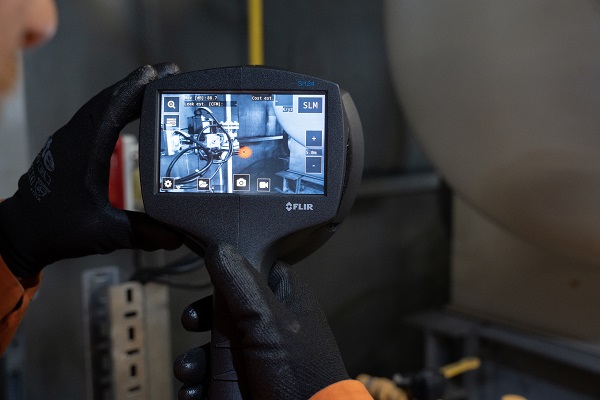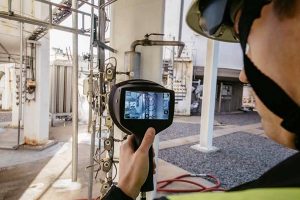Billions of dollars are spent each year on noise and sound insulation. Whether it’s automotive engineers seeking to reduce road noise on board vehicles, architects reducing noise pollution in buildings or chemical manufacturing companies protecting a workforce from excessive noise, the cost is huge both in terms of finance and time.
But however much we try, sound is all around us. Even in the quietest of environments sounds are emitted through particle movement. But what if that background noise tells a story?
A person with good hearing can detect sounds in the frequency range of 20 Hertz and 20,000 hertz (20KHz). But many naturally occurring sounds fall outside this frequency range and are therefore inaudible to humans. An electric circuit in operation, for example, might be emitting electrical discharge with an associated sound frequency considerably higher than 20KHz, thus seemingly silent to the human ear. Electrical partial discharge can generate acoustic emission signals from 20KHz to more than 100KHz.
But the frequency is not the only factor that needs consideration. Imagine a compressed air system with a complex array of air lines and associated joints. If a significant leak has occurred, often the first signal to an observer is the sound of the compressed air or gas leaking through the faulty joint. However, if the leak is extremely small the amount of noise can be inaudible to the human ear and hence go undetected. Another problem associated with compressed air systems is that the air transfer lines are often elevated several metres above the ground to avoid obstruction in the main construction area. This means that even if the air leak is audible on close inspection, the distance from the operator means it often goes unnoticed for a long time.
At this point you may be saying, “so what? What if there are a number of small air leaks in my compressed air system?” A well-known compressor manufacturer has estimated that the average leakage rate is about 25% with some plants losing about 80% of their compressed air through leaks.
The obvious ramification of air leaks is energy use. The majority of European manufacturers have faced huge energy increases in recent years and are seeking to reduce electricity consumption. Even very small leaks can amount to a significant monetary loss over a prolonged period. Many companies simply increase the operating pressure of the compressor to compensate for leaks, but this simply accentuates the problem as more gas leaks under the higher pressure, further increasing the electricity use and hence hurting the bottom line.
Whilst repairing these leaks is relatively simple, they often go undetected for many months given the often obscure and remote locations coupled with the extremely low level sounds emanating from the problematic air lines.
Imagine a solution in the form of an instrument containing not one but one hundred and twenty-four separate, highly sensitive microphones capable of detecting the slightest of sounds at several hundred feet and you have the Si124 acoustic camera from FLIR.
Introduced in 2021 the camera has been widely used across the globe to detect the slightest of leaks in compressed gas systems including large pneumatic assemblies and refrigerant gas systems too, saving industry millions of dollars in energy use, operational efficiency and unscheduled downtime.
The wide frequency range of the FLIR Si124 of 2 -65kHz means it can not only be used to detect faults on compressed lines but also used to detect electrical discharge. Unsurprisingly power generation companies, rail operators, and virtually any company utilizing high voltage systems have found the FLIR Si124 to be an invaluable piece of equipment, important not only in reducing maintenance on high voltage systems but in ensuring safety for employees and contractors.
When unboxing the FLIR Si124 Acoustic Imaging Camera the first thing any observer will notice is the lightweight nature of the unit, making extensive inspections effortless. The 124 microphones work together to produce a precise acoustic image that visually conveys ultrasonic information even in environments with loud background noises. Working in real time, the acoustic image is transposed to the screen on top of a visual image taken by the onboard digital camera allowing the operator to accurately pinpoint the source of the problem in an instant, meaning inspections can be carried out in a fraction of the time taken using traditional methods. The operator then utilises the FLIR Si124 Acoustic Camera Viewer cloud service to save images to the cloud after their capture, and to create reports for repair work orders. The system not only allows access to the stored images but to the associated sound files for a much deeper analysis and classification of problems.
The 100 meters+ detection range of the FLIR Si124 camera overcomes the problem of in-accessible and restricted areas. Even at these large distances the camera is capable of producing pin-sharp images allowing the user to identify exact problematic areas even against complex backgrounds. At close ranges, the improved sensitivity of the new camera really comes into it’s own; at 65kHz the high sensitivity is capable of detecting the tiniest of leaks.
The high definition colour screen is easy to read even in the most challenging of environments. Not only is the air or gas leak clearly located, by programming various variables on the camera it automatically calculates the annual financial loss caused by the air leak. This figure is displayed on the screen, providing an immediate quantifiable monetary value.
With the FLIR Si124 Acoustic Imaging Camera detecting the sound of silence has never been easier.
For more information contact your local FLIR agent or distributor.












